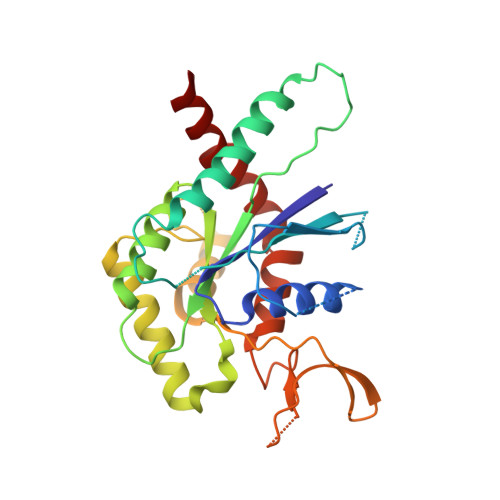The structure and properties of septin 3: a possible missing link in septin filament formation.
Macedo, J.N., Valadares, N.F., Marques, I.A., Ferreira, F.M., Damalio, J.C., Pereira, H.M., Garratt, R.C., Araujo, A.P.(2013) Biochem J 450: 95-105
- PubMed: 23163726
- DOI: https://doi.org/10.1042/BJ20120851
- Primary Citation of Related Structures:
3SOP - PubMed Abstract:
The human genome codes for 13 members of a family of filament-forming GTP-binding proteins known as septins. These have been divided into four different subgroups on the basis of sequence similarity. The differences between the subgroups are believed to control their correct assembly into heterofilaments which have specific roles in membrane remodelling events. Many different combinations of the 13 proteins are theoretically possible and it is therefore important to understand the structural basis of specific filament assembly. However, three-dimensional structures are currently available for only three of the four subgroups. In the present study we describe the crystal structure of a construct of human SEPT3 which belongs to the outstanding subgroup. This construct (SEPT3-GC), which includes the GTP-binding and C-terminal domains, purifies as a nucleotide-free monomer, allowing for its characterization in terms of GTP-binding and hydrolysis. In the crystal structure, SEPT3-GC forms foreshortened filaments which employ the same NC and G interfaces observed in the heterotrimeric complex of human septins 2, 6 and 7, reinforcing the notion of 'promiscuous' interactions described previously. In the present study we describe these two interfaces and relate the structure to its tendency to form monomers and its efficiency in the hydrolysis of GTP. The relevance of these results is emphasized by the fact that septins from the SEPT3 subgroup may be important determinants of polymerization by occupying the terminal position in octameric units which themselves form the building blocks of at least some heterofilaments.
Organizational Affiliation:
Centro de Biotecnologia Molecular Estrutural, Instituto de Física de São Carlos, Universidade de São Paulo, São Carlos, SP, Brazil.
















